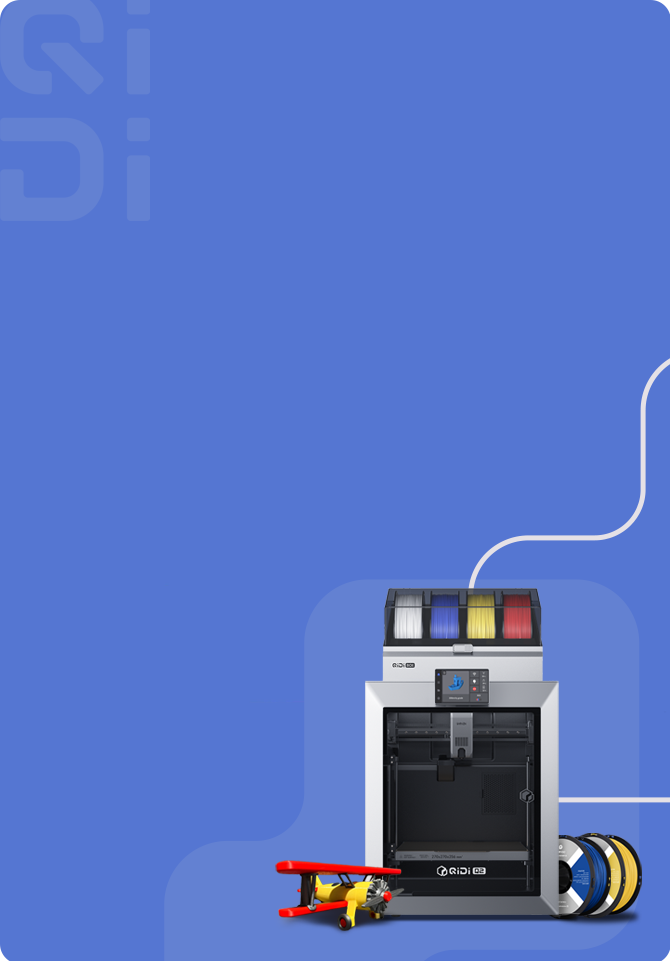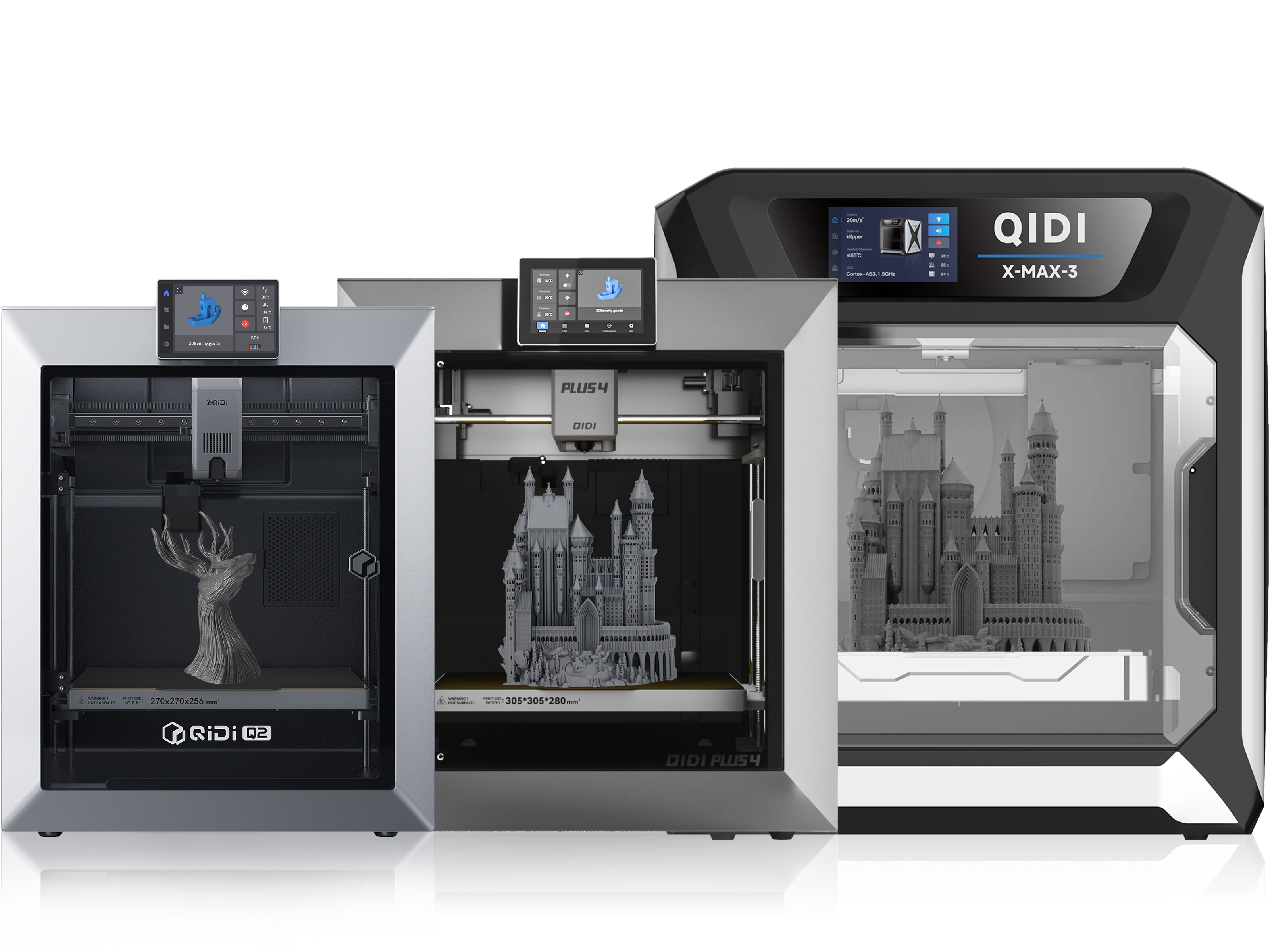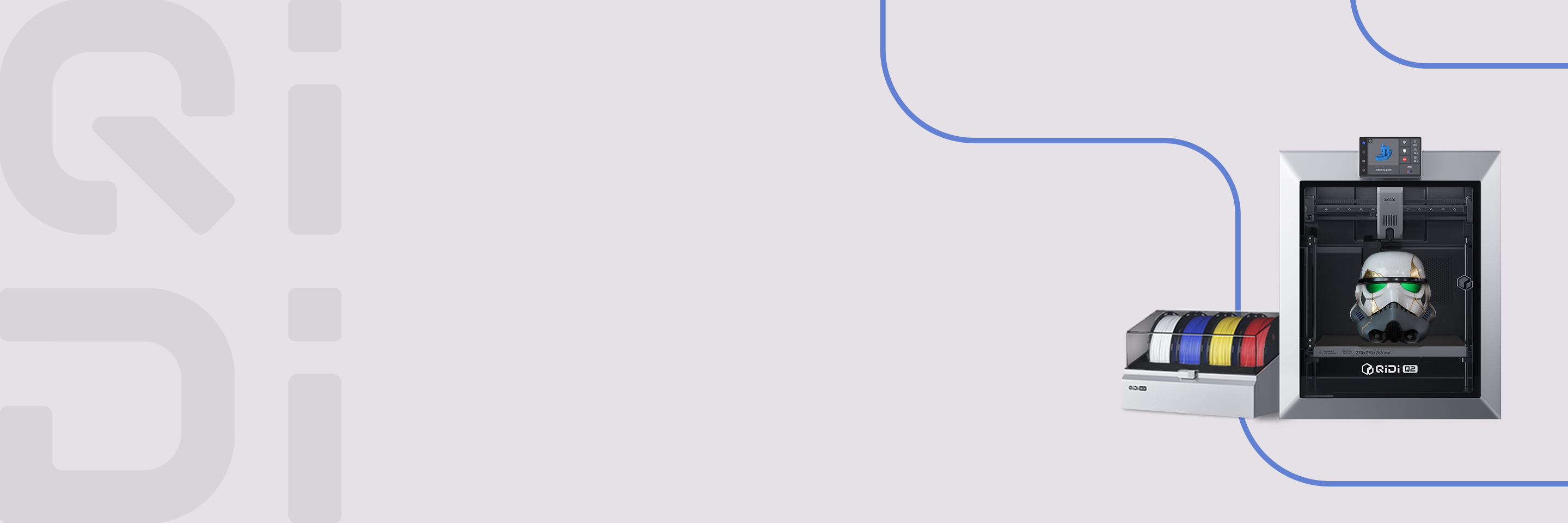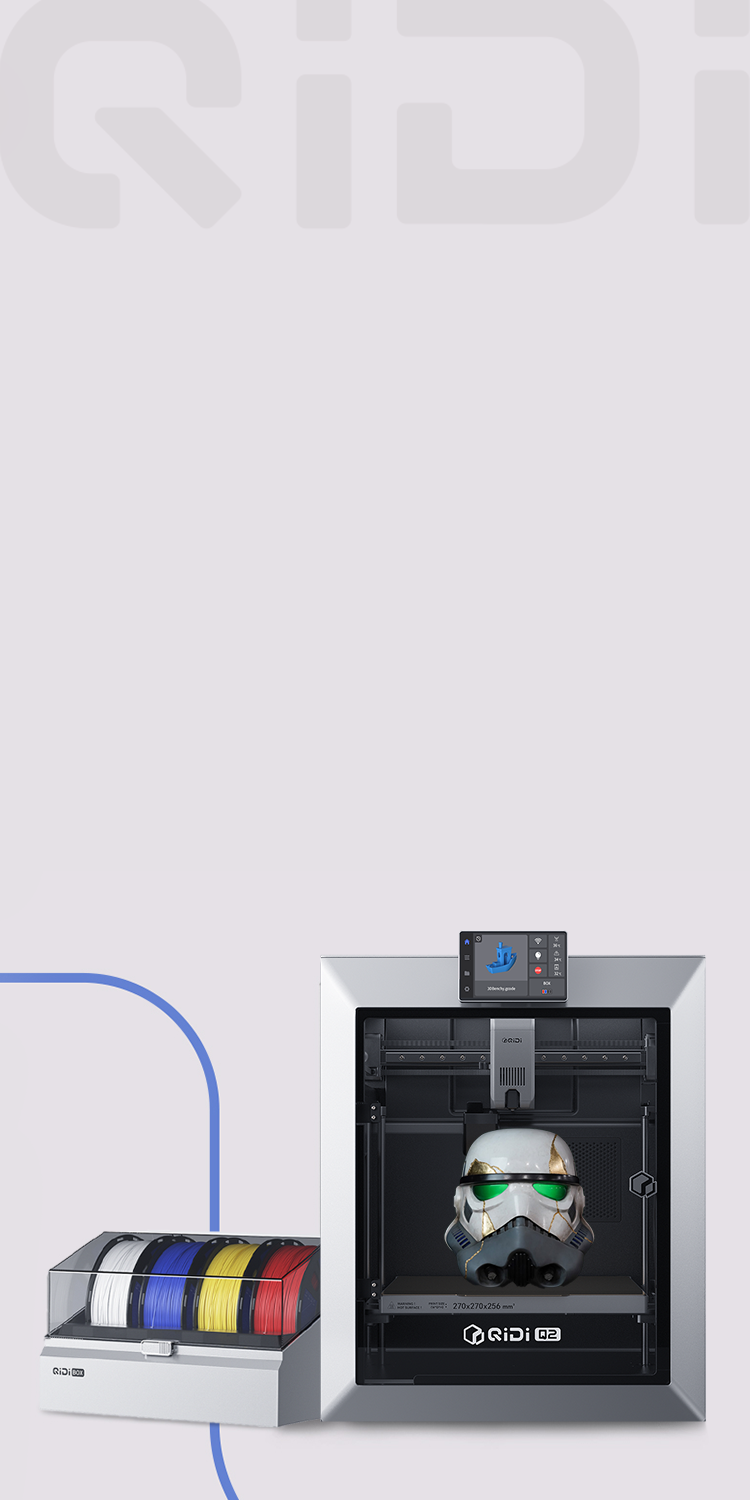3D nyomtatóvásárlási útmutató
Találd meg a tökéletes 3D-t
nyomtató a projektjeidhez.
Kezdje el kreatív kalandját még ma!
Életre hozza ötleteit a QIDI FDM 3D nyomtatókkal
A fúzionált leválasztásos modellezés (FDM) egy elterjedt 3D nyomtatási technológia, amely a QIDI kínálatának középpontjában áll.FDM 3D nyomtatókÚgy működnek, hogy hőre lágyuló szálakat hevítenek félfolyékony állapotba, majd rétegről rétegre precízen helyezik el őket egy építőplatformon, egy digitális 3D modell irányításával. Ez az additív gyártási folyamat lehetővé teszi összetett háromdimenziós tárgyak nagy pontosságú és ismételhetőségű létrehozását.
Az FDM nyomtatók a piacon kapható legnépszerűbb 3D nyomtatók közé tartoznak. Ez a fajta 3D nyomtató jó anyagkompatibilitással és felhasználóbarát alkalmazásokkal rendelkezik.
Anyag sokoldalúsága: Az FDM 3D nyomtatók számos hőre lágyuló anyagot támogatnak, beleértve a PLA-t, ABS-t, PETG-t, TPU-t stb. Minden anyag egyedi tulajdonságokkal rendelkezik, mint például a szilárdság, a rugalmasság, a hőállóság és az átlátszóság, és kiválaszthatja a legmegfelelőbbet. 3D nyomtatási anyag az Ön konkrét alkalmazásának megfelelően.
Költséghatékonyság: Más 3D nyomtatási módszerekkel összehasonlítva az FDM technológia általában megfizethetőbb. Az FDM nyomtatók ára viszonylag alacsony, és az alapanyagok (filamentek) ára is elfogadható. Ezáltal az FDM életképes választás a hobbi felhasználók, az oktatók, valamint a kis- és középvállalkozások számára.
Könnyen használható és karbantartható: FDM nyomtatóink egyszerű és áttekinthető kezelőpanellel vannak felszerelve, amely lehetővé teszi a kezdők számára, hogy a nyomtató alapvető funkcióit könnyedén kezeljék gombok megnyomásával vagy tekerőgombok elforgatásával. A kezelési folyamat intuitív és könnyen érthető. A karbantartás is egyszerű, főként a rendszeres tisztítást, a fúvókacserét és az alkalmi kalibrálást foglalja magában.
Az FDM 3D nyomtatókat számos területen használják, beleértve:
Napi szükségletek: Nyomtasson háztartási cikkeket, például mobiltelefon-tartókat, kulcstartókat, alátéteket, fűszertartókat, és irodaszereket, például irattartó dobozokat és egérpadokat.
Művészeti és dekoratív darabok: Szobrok, köztük absztrakt szobrok és meghatározott témájú szobrok készítésére, valamint egyedi ékszerek, például fülbevalók és nyaklánc medálok készítésére használják.
Oktatási modellek: Tanítási modellek készítése, például emberi szervmodellek a biológiaórákon, topográfiai modellek a földrajzórákon és geometriai modellek a matematikaórákon.
Ipari prototípusok & Egyedi alkatrészek: Termékprototípusok nyomtatása megjelenési és funkcionális teszteléshez a termékfejlesztés korai szakaszában, valamint egyedi alkatrészek nyomtatása speciális ipari berendezésekhez.
Orvosi & Egészségügyi alkalmazások: Készítsen személyre szabott ortopédiai eszközöket, például lábboltozat-támasztópárnákat és sebészeti útmutatókat a száj- vagy ortopédiai műtétek segítésére.
Ha nem biztos benne, hogy melyik 3D nyomtató a megfelelő az Ön számára, először tisztázhatja a nyomtatás célját vagy célját:
Nyomtatási cél
Fogyasztói szint (személyes/családi): alkalmas kis modellek, kreatív tervek nyomtatására, és általában alacsonyabb költségvetéssel, mint például Qidi Tech Q1 Pro.
Szakmai szint (oktatás/laboratórium): figyelembe kell vennie mind a pontosságot, mind a stabilitást, ami támogatja a nagy sebességű nyomtatást és az automatikus szintezést.
Ipari (termelés/gyártás) nyomtatók, mint például a QIDI Plus4 Nagy intenzitású gyártásra tervezték. Nagy gyártási térfogattal rendelkezik a nagy projektek kezeléséhez. A QIDI Plus4 fűtött kamrájának hőmérséklete 65°C, és támogatja a magas hőmérsékletnek ellenálló anyagokat, ami segít a kiváló minőségű nyomatok elérésében.
Nyomtatási célpont
Modell mérete: Az ipari szint nagy beépítési méretet igényel, míg a fogyasztói szint főként 200-300 mm³.
Anyagkompatibilitás: Ha műszaki műanyagokat kell nyomtatnia (ABS, nejlon) vagy kompozit anyagok (szénszálas erősítésű) esetén olyan modellt kell választania, amely támogatja magas hőmérsékletű fúvókák és zárt szerkezet.
Megvizsgálhatja a teljesítményparamétereket is, például a nyomtatási pontosságot. A nyomtatási pontosságot olyan tényezők mérik, mint a rétegmagasság és a fúvókaátmérő. A kisebb rétegmagasságok és fúvókaátmérők általában nagyobb felbontású nyomatokat eredményeznek finomabb részletekkel. Ha a projektje nagy pontosságú alkatrészeket igényel, keressen olyan nyomtatót, amely kisebb rétegmagasságokat tud elérni, és kisebb fúvókaopciókkal rendelkezik.
GYIK
Keresse meg a válaszokat a legsürgetőbb kérdéseire a 3D -s nyomtatógépeinkkel és szolgáltatásainkkal kapcsolatban.
Az FDM 3D nyomtató, más néven olvasztott lerakódási modellező nyomtatók, egy nyomtató, amely objektumokat hoz létre az olvadt műanyag izzószál rétegről történő lerakódásával. A műanyag izzószálat addig melegítik, amíg az olvadtá nem válik, és egy fúvókán keresztül extrudálódik, hogy kialakítsák az érdeklődés alakját. Az egyik oka annak, hogy az FDM nyomtatók népszerűek, hogy olcsók és nagyon könnyen használhatók, tehát a kezdők és a professzionális felhasználók széles körben használják őket.
Az FDM 3D nyomtatóknak számos előnye van. Az első az, hogy általában költséghatékonyabbak, mint más típusú 3D nyomtatási technológiák. Ez a gazdaság hozzáférhetővé teszi őket széles piacon, például a hobbisták, az oktatók és a szakemberek számára. Másodszor, az FDM nyomtatók felhasználóbarátak és széles körű anyagok befogadása, a keménytől a mérnöki szintű hőre lágyuló műanyagokig, mint például az ABS és a PLA. Ezek a nyomtatók sokoldalúak, amelyek lehetővé teszik az alkalmazások széles körében történő felhasználását, a prototípus készítésétől a funkcionális alkatrészek tervezéséig. Az előállított alkatrészek erősek, és ellenállnak a mechanikai felhasználásnak. A működési költségek szintén alacsonyak, mivel nem igényel semmilyen veszélyes vegyi anyagot, így biztonságos és könnyen futtatható.
Az FDM 3D nyomtatási folyamat magában foglalja a 3D modell tervezését a CAD szoftver segítségével. Miután a formatervezés készen áll, a szeletelő szoftvert használják a modell különféle rétegekké történő átalakításához. A nyomtató ezután melegíti a műanyag szálát, és egy fúvókán keresztül extrudálja, az egyes réteget a szeletelt modell szerint. Amint a réteg le van állítva, lehűl és megszilárdul, felépítve a végső tárgyat. Ez a rétegenkénti mechanizmus biztosítja a végső objektum alakját és szerkezetét.
Az SLA és az FDM két különböző 3D nyomtatási technológia. A fő különbség az anyag és a folyamat. Az FDM nyomtatók hőre lágyuló szálakat használnak, amelyeket megolvasztanak és extrudálnak a rétegek leállításához. Az SLA nyomtatók folyékony gyantát használnak, amelyet lézer gyógyít az egyes rétegek gyógyításához. Az SLA általában jobb felbontással van, és a felületek simábbak, tehát nagyon alkalmas a mintákra, nagyon részletekkel és nagyon bonyolult. Az FDM jobban alkalmas funkcionális prototípusokra és nagyobb alkatrészekre, mert erősebb és olcsóbb. Általában az FDM olcsóbb az SLA -nyomtatókhoz és azok anyagához képest.
A nyomtatási felbontás, a rétegmagasság, az extruder és a platform hőmérséklete, a nyomtatási sebesség, az izzószál minősége, a fúvóka méret és a megfelelő szeletelő beállítások mind befolyásolják a végső nyomtatási minőséget. A kettős extrudálás, a zárt építési kamra és az automatikus kalibrációs tulajdonságok szintén javítják a következetességet, a pontosságot és a megbízhatóságot.

 Q2
Q2
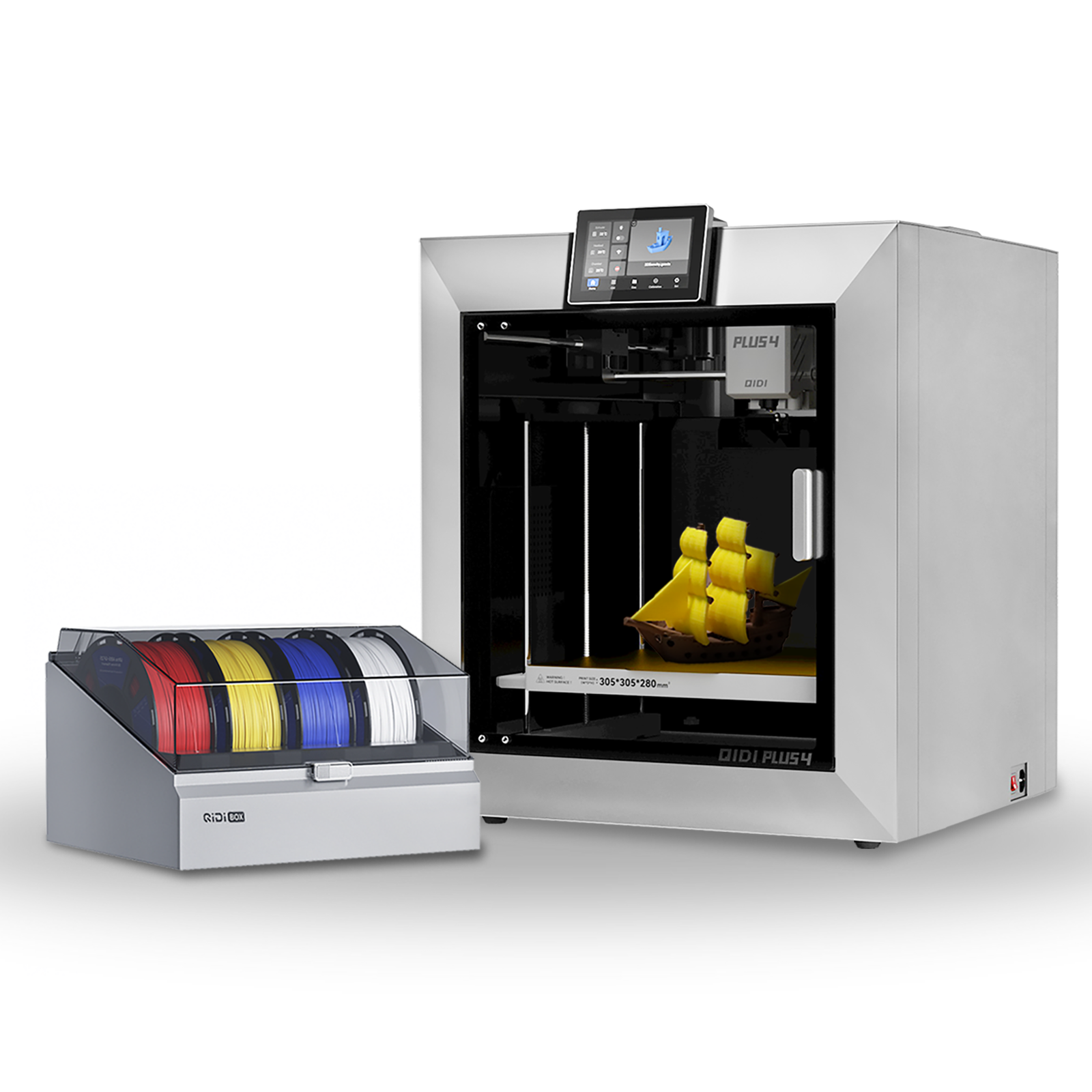 Plusz4
Plusz4
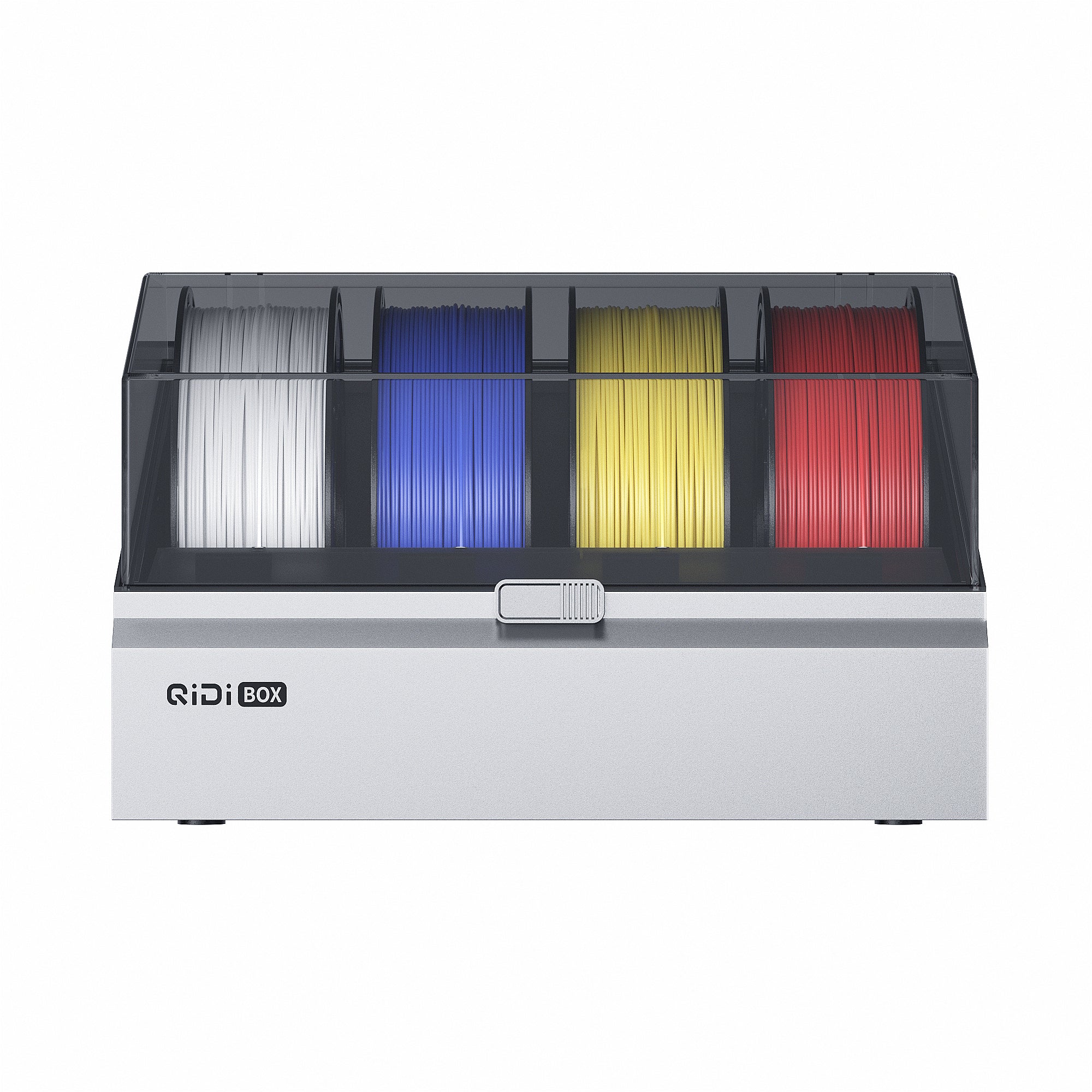 Qidi doboz
Qidi doboz
![[Qidi X-CF Pro, speziell für den Druck von Kohlefaser und Nylon entwickelt] - [QIDI Online Shop DE]](http://eu.qidi3d.com/cdn/shop/files/3034a1133efe01daba919094b70c6310.jpg?v=1750300120) Q1Pro
Q1Pro
![[Qidi X-CF Pro, speziell für den Druck von Kohlefaser und Nylon entwickelt] - [QIDI Online Shop DE]](http://eu.qidi3d.com/cdn/shop/products/X-MAX3-3D-Printer-02.png?v=1750300138) Max3
Max3
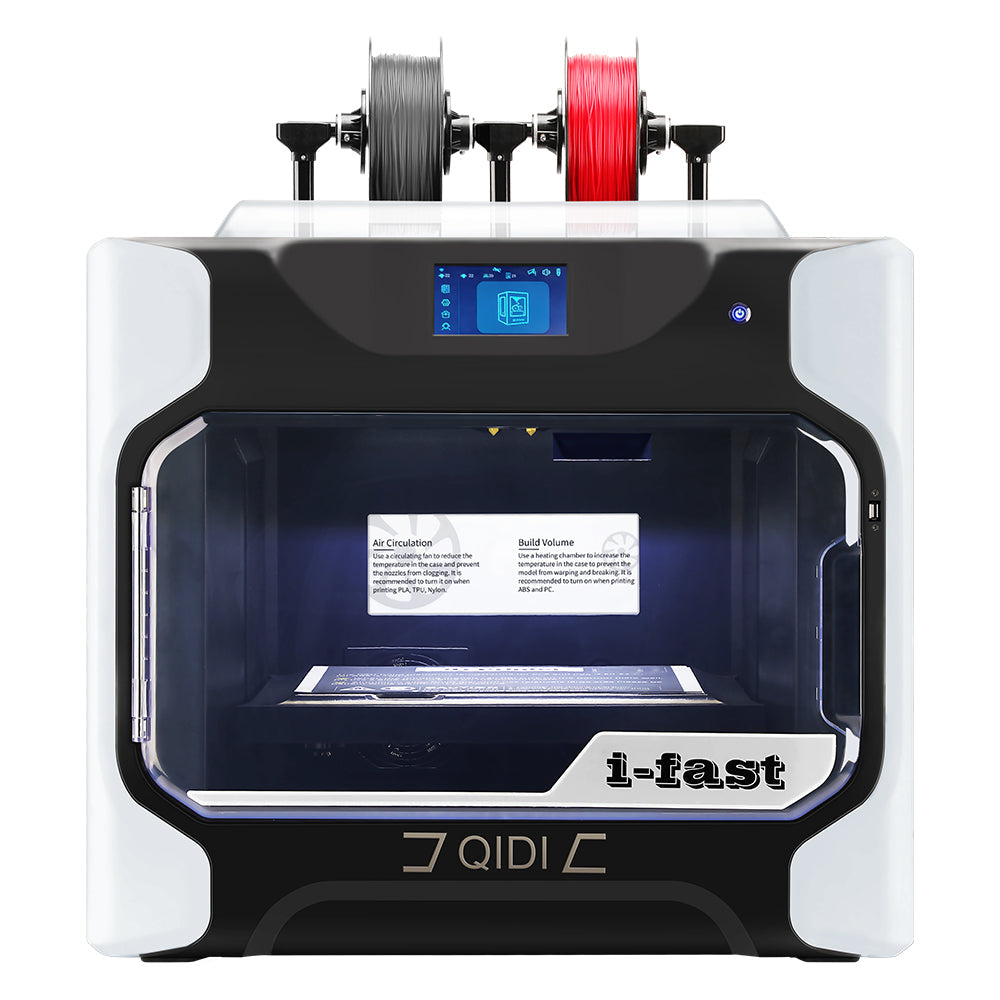 Igyem
Igyem



